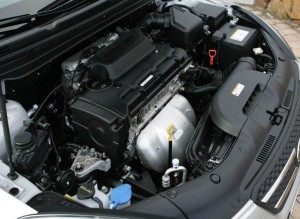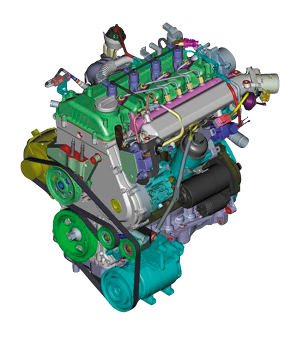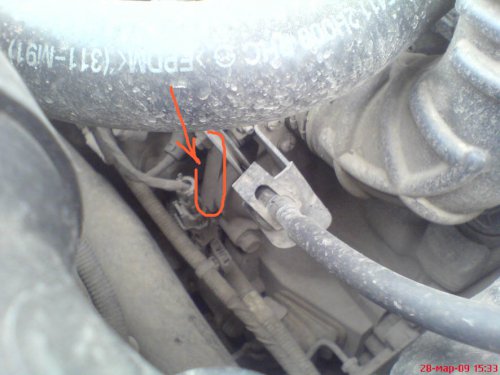Most, studying the parameters of the engine of the purchased car, will pay special attention to its three evaluation criteria - power, torque and volume. If the first two parameters are still clear, then with the third, if you think about it, it may be difficult. What volume power unit better and what does this parameter affect? The answer seems to be clear - the larger the value, the better. Really powerful engine can quickly disperse the car, but it will spend more fuel. A small-volume motor spends less, but its speed capabilities are not enough. Given the factor that the tax calculated on the volume increases annually, the question of the importance of a competent choice of engine is quite serious.
It is quite difficult to understand exactly how it is calculated this characteristic. The total volume of the engine is considered to be equal to the sum of the volumes of its combustion chambers. It can be calculated both in cm3 and m3. If the parameter in cm3 is accurate, then in the second, the indicator is rounded to the nearest integer.
Available Options
Consider the value of the engine size using the example of the second generation Kia Sid.
There are two options available for it today.
Let's start the comparison with the economy of purchase and operation
economy
 By purchasing a car with a Kia Sid 1.4 liter engine, the buyer, firstly, saves at least fifty to sixty thousand on the cost of the car, and, secondly, the amount of tax and insurance will be lower. Thirdly, fuel consumption should also be taken into account. The smaller volume of combustion chambers allows you to use less fuel.
By purchasing a car with a Kia Sid 1.4 liter engine, the buyer, firstly, saves at least fifty to sixty thousand on the cost of the car, and, secondly, the amount of tax and insurance will be lower. Thirdly, fuel consumption should also be taken into account. The smaller volume of combustion chambers allows you to use less fuel.
Let's calculate the maximum autonomous mileage of the car. For calculations, we take consumption in a mixed travel mode. With the same volume fuel tank at 53 liters, it will run approximately 868 km, and a more powerful one - 803 km. By modern standards, 50-60 km, of course, may not be a distance, but, nevertheless, the difference in distance is quite pleasant from a financial point of view. If you make calculations on fuel consumption in other modes, then the difference in mileage can be even more significant. And this will save a good amount on the cost of fuel.
As a result, the less powerful engine wins in this parameter.
Driving performance
But according to driving performance he loses to a more powerful fellow. Of course, he has fewer horses, but the time to reach maximum torque is also less. As a result, during acceleration, he will be able, at some point, to gather more strength and pull ahead. Naturally, then a more powerful engine will surpass it in strength and get ahead. On the track, the Kia Sid 1.6 engine is more preferable, because it allows you to develop a greater top speed. But at the same time, the load on all other parts of the car increases, so it will most likely have to be repaired more often.
As for the Kia Sid 2.0 engine, its gasoline version was available for the first generation. For the second generation, only a diesel version is offered, but cars with it are not delivered to Russia. Note that according to unconfirmed reports, Kia Motors is still going to offer Kia variant Sid engine capacity, which will be equal to two liters.
It is worth choosing based on the tasks facing you. If you only move around the city, then it is better to take a less powerful car. You won’t have to accelerate much, and fuel consumption will be lower. If your job is to travel outside the city, then a more powerful engine will allow you to spend less time and overcome all obstacles with less effort.
golf class car Kia Ceed ranks next in order of precedence model range KIA after Rio. The model was created specifically for Europeans and received a “trolley” from the Hyundai-Kia J5, on which many models of the South Korean brand are based.
Kia-Hyundai G4FA engine

The G4FA power unit entered the new Gamma series, which appeared on the motor market in 2007 and replaced the archaic Alpha engines. This series includes only two power units - G4FA for 1.4 liters and G4FC for 1.6 liters.
Unlike the outdated Alpha, the 1.4-liter G4FA uses a timing chain drive with a tensioner that is designed for the entire life of the engine. On the intake shaft there is a system for changing the phases of gas distribution. There are no hydraulic lifters and every 95 thousand kilometers it is necessary to adjust the valve clearances.
The main disadvantages of the Chinese engine include knocking in the engine, which sometimes disappears when warmed up. This means timing chain noise. If such noise is heard when hot, then the problem is unadjusted valves.
The nozzles in the G4FA engine are also “musical” and can make clicks, chatter, clatter and more.
When oil leaks, pay attention to the valve cover.
A clogged throttle is to blame for the floating speed.
Vibrations at the twentieth also appear with a dirty throttle or candles.
The nature of the occurrence of vibrations at medium speeds cannot be explained even by manufacturers who consider this a feature of the motor.
Weak alternator belt tension provokes a whistle.
It is noted that the shortcomings of the Kia-Hyundai G4FA engine appear from the very beginning of operation, besides, they are not repairable and it is necessary not to bore the cylinders, but to change the entire block.
Engine Kia-Hyundai G4FC
The G4FC motor, also included in the Gamma family, differs from its counterpart only in an increased crankshaft piston stroke, but otherwise it is completely identical to the G4FA. In particular, the G4FC engine received an IFGR system on one shaft, a timing chain drive, and so on.
In addition, the Kia-Hyundai G4FC power unit has a Gamma II modification with a gas distribution phase change system on two shafts, which has a positive effect on power, which reaches 128-130 hp.
Western consumers have the option to purchase Kia Ceed with G4FC direct injection GDI (G4FD) and turbocharged T-GDI (G4FJ) engines.
All the shortcomings of the Kia-Hyundai G4FC engine coincide with the disadvantages of the G4FA engine, but if you can choose a motor, experts advise opting for a larger version.
|
Engines |
Kia-Hyundai G4FA |
Kia-Hyundai G4FC |
|
Production |
Beijing Hyundai Motor Co. |
Beijing Hyundai Motor Co. |
|
Engine brand |
||
|
Release years |
2007 - our time |
2007 - our time |
|
Block material |
aluminum |
aluminum |
|
Supply system |
injector |
injector |
|
Number of cylinders |
||
|
Valves per cylinder |
||
|
Piston stroke, mm |
||
|
Cylinder diameter, mm |
||
|
Compression ratio |
||
|
Engine volume, cc |
||
|
Engine power, hp / rpm |
||
|
Torque, Nm/rpm |
||
|
Environmental regulations |
||
|
Engine weight, kg |
||
|
Fuel consumption, l/100 km (for Celica GT) |
||
|
Oil consumption, g/1000 km |
||
|
Engine oil |
0W-30 |
0W-30 |
|
How much oil is in the engine |
||
|
Oil change is carried out, km |
||
|
Operating temperature of the engine, hail. |
||
|
Engine resource, thousand km |
||
|
tuning |
||
|
The engine was installed |
Hyundai Solaris |
Hyundai Solaris |
The range of engines is represented by three petrol models with a working volume of 1.4, 1.6 and 2 liters, as well as two diesel engines: 1.6 and 2 liters. Let me take a closer look at each of them:
Petrol 1.4 and 1.6 (Gamma)
We will consider these engines in pairs, as they are distinguished only by the displacement and VSH (external speed characteristic). The power unit is an in-line four with two overhead camshafts (DOHC). I would also like to note that the CVVT system of constantly variable valve timing works on the engines. Of the undoubted advantages, the following points can be distinguished:
The engine is a completely new development, namely:
Modernized crank mechanism.
Aluminum cylinder block.
Reduced weight and friction.
Optimized intake and exhaust manifolds.
Low fuel consumption and CO2 emissions.
Gasoline 2.0l (Beta)
 This engine has gained confidence with its unpretentiousness to fuel quality, simplicity and reliability of the time-tested design. Here the same layout is used as on the engines of the Gamma series - 4 cylinders in a row and 16 valves (2 camshafts) with a system of constantly variable valve timing CVVT. The advantages of this power unit are:
This engine has gained confidence with its unpretentiousness to fuel quality, simplicity and reliability of the time-tested design. Here the same layout is used as on the engines of the Gamma series - 4 cylinders in a row and 16 valves (2 camshafts) with a system of constantly variable valve timing CVVT. The advantages of this power unit are:
Low noise level.
Changed piston shape, graphite coating.
Optimized cavity resonator.
Diesel 1.6l.(U-V.G.T)
 The diesel engine is the latest development of the Kia concern and is equipped with an advanced second-generation Common Rail fuel injection system. The undeniable advantage of such a system is the ability to individually control the injection advance and the amount of injected fuel for each cylinder, which reduces fuel consumption, noise, and increases acceleration dynamics and engine elasticity. Summarizing the advantages of this unit, we have:
The diesel engine is the latest development of the Kia concern and is equipped with an advanced second-generation Common Rail fuel injection system. The undeniable advantage of such a system is the ability to individually control the injection advance and the amount of injected fuel for each cylinder, which reduces fuel consumption, noise, and increases acceleration dynamics and engine elasticity. Summarizing the advantages of this unit, we have:
Flat torque curve at high speed engine.
Excellent fuel efficiency and low CO2 emissions
Diesel 2.0l.(D-V.G.T)
 The 2.0-litre diesel is also equipped with a second-generation Common Rail fuel injection system ( operating pressure 1,600 bar). One of the few differences between the two-liter diesel and its little brother is the presence of a single overhead camshaft (SOHC). The pros are as follows:
The 2.0-litre diesel is also equipped with a second-generation Common Rail fuel injection system ( operating pressure 1,600 bar). One of the few differences between the two-liter diesel and its little brother is the presence of a single overhead camshaft (SOHC). The pros are as follows:
Second generation Bosch Common Rail fuel injection system (pressure 1,600 bar)
32 bit The electronic unit Engine control (ECU)
Electronic control of the EGR valve and cooling.
Intake air flow control system.

Room location is marked in red kia engine cee "d.
Engine 1.6 gasoline. Circled in red is the engine number. Shot from the left headlight.

Engine number decoding
1. Fuel type
2. Engine type
4: 4 stroke 4 cylinder
6: 4 stroke 6 cylinder
3 - 4. Engine type, sorted by power
FA: γ engine, 1396cc (Petrol)
FB: U engine, 1582cc (Diesel)
FC: γ engine, 1592cc (Petrol)
GC: β engine, 1975cc (Petrol)
EA: D engine, 1991cc (Diesel)
5. Year of production
4: 2004, 5: 2005, 6: 2006, 7: 2007
6. Engine number in order
Answers to frequently asked questions (FAQ)
What kind of oil is poured from the factory into KIA cars?
For gasoline engines: Shell 5W-30 or HK GLF 5W-20
For diesel engines: HK LS 5W-30 or HK SD5W-30
How many liters of gasoline are left in the tank when the red light on the dash lights up?
As soon as the computer shows that there are less than 50 km left to drive, i.e. dashes will flash - you can safely pay for 45 liters, in fact, there will still be 6-8 liters left in the tank. Naturally, you can drive more than 50 km. Apparently this reserve (2 liters) is designed for the unexpected. Convinced by experience.
However, taking into account that the fuel pump is submersible and is cooled by the gasoline in the tank, driving “on a light bulb” all the time is highly undesirable, especially in the heat.
What kind of oil filter do we have?
For KIA CEED and KIA CEED FL (2007-2011) dorestyle and restyling
For gasoline engine 1.4, 1.6 liters: oil filter engine - No. 26300-35503, as well as 26300-35501 and 26300-35502;
For a 1.6 liter diesel engine: engine oil filter - No. 263202A500, as well as 26320-2A002 and 26320-2A001;
For a 2.0 liter diesel engine: engine oil filter - No. 2632027401 and 2632027400.
For KIA CEED 2012 second generation
For gasoline engine 1.4, 1.6 liters: engine oil filter - No. 26300-35530
Sometimes reverse gear does not turn on on a manual gearbox
When the clutch is released, instead of driving, a characteristic screech is heard from the box - this is a problem in the “non-engagement”
This is due to the fact that the reverse gear does not have a shaft synchronizer.
The following solutions have been found:
Turn on reverse gear after a complete stop of the car, if the gear is not engaged, shift the gearshift knob to the “neutral” position and after waiting about 3 seconds, repeat the gear shift.
Engage reverse gear as usual and then very smoothly bring the clutch to the moment where it “usually grabs” and push the gear lever further without effort. You should feel how the transmission is switched on.
When you lift the gearshift knob up, at the end you need to apply some effort. You can even feel whether the speed has turned on or not - when you turn it on correctly, you feel such a click (gear engagement). If not, the lever back a little and up again.
What fuel pressure does the fuel pump pump on a 1.6L gasoline engine?
338-348kpa(3.45-3.55kgf/cm2)(49.0-50.5psi)
What fluid to fill in automatic transmission?
Gear oil meeting the SPIII specification from the following manufacturers: Mitsubishi (Diamond, DiaQueen), BP Autran, Chevron, Ravenol.
What spark plugs are on our engines? And how to change them?
For gasoline 1.4, 1.6 liters: NGK ZFR5F-11. Thread diameter 14mm, thread pitch 1.25. Since 2009, a modified block head can be installed on 1.6l (G4FC) engines! It uses candles with a long skirt 26.5 and a diameter of 12mm -.
For gasoline 2.0 liters: NGK BKR5E-11 (1881411051).
Replacement procedure for gasoline: remove the top cover, there is a coil on each candle, a bolt (10) on each coil, unscrew all 4 bolts and simultaneously remove 4 coils.
Do the engines have hydraulic lifters?
Hydro compensators are only for diesel engines volume of 1.6 and 2.0 liters.
How are valves adjusted on gasoline engines and when?
The valves are adjusted as necessary, after checking, at a mileage of 75,000 km and 150,000 km. For 1.4 and 1.6 liters - cups, for 2.0 - washers.
